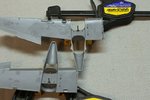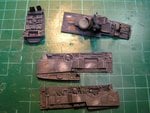Erich
the old Sage
Nasm have designated this Uhu as an A-2/R4
The topic was about the color of the 'squiggle' camouflage appearing to be the mysterious RLM 84. I just received a reply from the museum project director, Mr. Tom Dietz confirming the color is what is known as RLM 84.
Quoted Text
Dear Mr. Boucher:
The color used for the squiggle pattern was matched to well preserved paint found under the aircraft's empennage. It is one of the undocumented late war "duck egg green" colors that started to appear in the fall of 1944. It's very similar to RAF Sky. On the upper surfacesof the NASM He 219, it was applied in a squiggle pattern over a base of RLM 75. The aircraft's undersurfaces, fuselage sides, and the vertical stabilizers were black when it left the factory in November 1944. At some point these surfaces were overpainted with the same "duck egg green" color as had been used for the upper surface camouflage. We decided to restore the aircraft to its appearance when it left the factory. No unit markings were uncovered.
The aircraft's engines and wings will enter the shop for restoration later this year. Once that work is completed, they will be joined to the fuselage at the Hazy Center.
Thomas J. Dietz
Museum Specialist
Aeronautics Division
National Air and Space Museum
Washington, DC
The topic was about the color of the 'squiggle' camouflage appearing to be the mysterious RLM 84. I just received a reply from the museum project director, Mr. Tom Dietz confirming the color is what is known as RLM 84.
Quoted Text
Dear Mr. Boucher:
The color used for the squiggle pattern was matched to well preserved paint found under the aircraft's empennage. It is one of the undocumented late war "duck egg green" colors that started to appear in the fall of 1944. It's very similar to RAF Sky. On the upper surfacesof the NASM He 219, it was applied in a squiggle pattern over a base of RLM 75. The aircraft's undersurfaces, fuselage sides, and the vertical stabilizers were black when it left the factory in November 1944. At some point these surfaces were overpainted with the same "duck egg green" color as had been used for the upper surface camouflage. We decided to restore the aircraft to its appearance when it left the factory. No unit markings were uncovered.
The aircraft's engines and wings will enter the shop for restoration later this year. Once that work is completed, they will be joined to the fuselage at the Hazy Center.
Thomas J. Dietz
Museum Specialist
Aeronautics Division
National Air and Space Museum
Washington, DC


